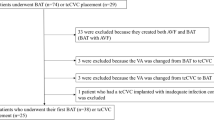Abstract
Distal revascularization-interval ligation (DRIL) empirically corrects steal after arteriovenous fistula (AVF) creation in most cases, but because there is no topologic alteration in anatomy, it is unclear as to why it is effective. To explore this issue, nine symptomatic patients underwent intravascular pressure and flow measurements before and after DRIL following upper arm autologous AVFs. Mean pre-DRIL systolic pressure (mmHg; mean ± SD) in the proximal brachial artery (PROX) was 102 ± 17, while that at the AV anastomosis (AV ANAST) was 47 ± 38 (p < 0.0006). Flow (mL/min) distal to AV ANAST was retrograde with the fistula open (−21 ± 64) but became antegrade (58 ± 29; p < 0.03) with occlusion of the fistula. Following DRIL, pressures at both PROX and AV ANAST sites did not change (104 ± 24 and 51 ± 43, respectively). However, pressure at the point at which the blood flow split to supply the hand or the fistula, now PROX, increased from 47 ± 38 (pre-DRIL AV ANAST) to 104 ± 24 (p < 0.0001). Pressure in the brachial artery distal to the ligature increased to 104 ± 27 (p < 0.0001), flow at this point (to the hand) became antegrade (51 ± 39; p < 0.03), and occlusion of the fistula did not significantly change pressure at this site. We hypothesize that improvement in hand perfusion following DRIL is due to a higher pressure at the point at which the blood flow splits to supply both hand and fistula (pre-DRIL: AV ANAST; post-DRIL: PROX), allowing antegrade flow down the new bypass to the lower pressure forearm. This increased pressure must be due to the increased resistance of the fistula created by interposing the arterial segment between the original AV ANAST and new PROX ANAST. As such, DRIL is schematically equivalent to banding, but resistance is increased in a fashion that is physiologically and empirically acceptable.




Similar content being viewed by others
References
ML Nicholson GJ Murphy (2000) Surgical considerations in vascular access PJ Conlon SJ Schwab ML Nicholson (Eds) Hemodialysis Vascular Access: Practice and Problems Oxford University Press Oxford 101–123
SE Wilson (1996) Complications of vascular access procedures SE Wlison (Eds) Vascular Access: Principles and Practice EditionNumber3 Mosby St. Louis 212–224
GB Zibari MS Rohr MD Landreneau et al. (1988) ArticleTitleComplications from permanent hemodialysis vascular access Surgery 104 681–686 Occurrence Handle1:STN:280:BiaD3MbnvVA%3D Occurrence Handle3175866
AH Morsy M Kulbaski C Chen H Isiklar AB Lumsden (1998) ArticleTitleIncidence and characteristics of patients with hand ischemia after a hemodialysis access procedure J Surg Res 74 8–10 Occurrence Handle1:STN:280:DyaK1c7pvVSluw%3D%3D Occurrence Handle9536965
H Schanzer M Schwartz E Harrington M Haimov (1988) ArticleTitleTreatment of ischemia due to “steal” by arteriovenous fistula with distal artery ligation and revascularization J Vasc Surg 7 770–773 Occurrence Handle1:STN:280:BieB3s%2FmvVI%3D Occurrence Handle3373618
SS Berman AT Gentile MH Glickman et al. (1997) ArticleTitleDistal revascularization-interval ligation for limb salvage and maintenance of dialysis access in ischemic steal syndrome J Vasc Surg 26 393–404 Occurrence Handle1:STN:280:ByiH2Mzps1E%3D Occurrence Handle9308585
RC Knox SS Berman JD Hughes AT Gentile JL Mills (2002) ArticleTitleDistal revascularization-interval ligation: a durable and effective treatment for ischemic steal syndrome after hemodialysis access J Vasc Surg 36 250–256 Occurrence Handle12170205
H Schanzer M Skladany M Haimov (1992) ArticleTitleTreatment of angioaccess-induced ischemia by revascularization J Vasc Surg 16 861–866 Occurrence Handle1:STN:280:ByyD1MrhvFI%3D Occurrence Handle1460712
C Sessa M Pecher J Maurizi-Balzan et al. (2000) ArticleTitleCritical hand ischemia after angioaccess surgery: diagnosis and treatment Ann Vasc Surg 14 583–593 Occurrence Handle1:STN:280:DC%2BD3M7hsValsQ%3D%3D Occurrence Handle11128452
KB Kwun H Schanzer N Finkler M Haimov L Burrows (1979) ArticleTitleHemodynamic evaluation of angioaccess procedures for hemodialysis Vasc Surg 13 170–177
S Balaji JM Evans DE Roberts CP Gibbons (2003) ArticleTitleTreatment of steal syndrome complicating a proximal arteriovenous bridge graft fistula by simple distal artery ligation without revascularization using intraoperative pressure measurements Ann Vasc Surg 17 320–322 Occurrence Handle1:STN:280:DC%2BD3s3mtVyjtg%3D%3D Occurrence Handle12704547
Author information
Authors and Affiliations
Corresponding author
Additional information
Presented at the Twenty-ninth Annual Meeting of the Peripheral Vascular Surgery Society, Anaheim, CA, June 4-5, 2004.
About this article
Cite this article
Illig, K.A., Surowiec, S., Shortell, C.K. et al. Hemodynamics of Distal Revascularization-Interval Ligation. Ann Vasc Surg 19, 199–207 (2005). https://doi.org/10.1007/s10016-004-0162-y
Published:
Issue Date:
DOI: https://doi.org/10.1007/s10016-004-0162-y




